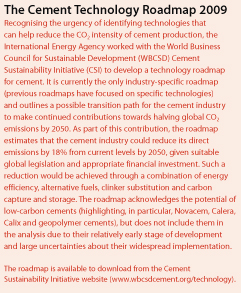The Future for Low Carbon Cements
The cement industry contributes around 5% of current global manmade carbon emissions. In this context, it is hardly surprising that a wide range of new cements have been proposed. After all, the holy grail of low-carbon or carbon-negative cement that is viable on a global scale promises to be extremely lucrative. However, despite some large claims, these cements are still largely at the development stage. Dr Richard Westaway, IMS Consulting, UK, examines why this remains the case.
A critical component
There are some very good reasons why cement, mainly through its use in concrete, has become a vital part of our everyday lives. No other building material currently available can match concrete in terms of its strength, performance, availability and affordability. Looking ahead, concrete is widely expected to be a critical component of the zero-energy buildings of the future.1 Similarly, the use of heavy building materials, such as concrete, has been found to be one of the most successful passive cooling adaptation options to help keep internal temperatures low in a warming climate.2

Carbon conscious
But in an increasingly carbon-conscious world, cement poses a fundamental problem. Demand for cement will undoubtedly increase, and with it emissions will rise. Approximately 1.9 gigaton of CO2 was emitted during Portland cement manufacture in 2006 according to the International Energy Association (IEA), an average of 700 kg of CO2 for every t of cement produced. The challenge for the cement industry is to balance growing demand with the need to adopt more sustainable practices.
One approach is to improve current practices, and efforts towards this are well underway. A complementary, and potentially highly profitable, approach is to develop new cements or cement substitutes that require less energy and produce less CO2 during manufacture. The former British Cement Association (BCA), now called the Mineral Products Association, has previously examined the prospects for low energy, low carbon cements in a factsheet,3 and characterises them as having some or all of the following properties:
- Manufactured using a process that utilises low carbon fuels and raw materials.
- Based on a chemical process that produces little or no CO2.
- Embody less energy than standard Portland cements, including those that contain additional inorganic/mineral constituents.
- Reduce waste and emissions during production.
- Produce a cement that is carbon neutral or carbon negative during its lifetime.

Limiting factors
In recent years, various low carbon cements have been proposed, but, with such an apparent array of low carbon cements to choose from, why is it that none have been taken up more widely? Three broad reasons can be identified: geographic; societal and economic.
One key limiting factor for low energy, low carbon cements is the geological distribution of the raw materials required. The BCA factsheet cites the example of magnesium oxide-based cements. Increasing their production depends on the availability of the basic raw materials and their proximity to production facilities. The preferred raw material is magnesite, but the estimated large reserves are distributed irregularly around the world. In areas where magnesite is absent, other sources of magnesium carbonate would be required, such as dolomitic limestone with high magnesium content. Any switch towards dolomitic limestone would inevitably lead to increases in traffic movement and costs, and ultimately the development of new production facilities closer to dolomitic limestone reserves, involving further financial investments and environmental impacts.
The exact physical properties of the new cements are also unknown, and it has yet to be established whether concrete produced using these is as durable as standard products. Social acceptance is perhaps even more of a challenge. The construction sector is sometimes accused of being conservative in its uptake of new ideas, products and processes, but this ethos arises from fundamental moral and legal obligations on engineers, architects and constructors to design and build safe structures. When major failures do occur, the legal, financial, reputational and psychological consequences for the firms and individuals involved are enormous.
There are, of course, economic considerations too. The price associated with the embodied carbon of any industrial product or process is likely to rise over coming years, perhaps as energy prices increase or as carbon trading schemes become established. This is ultimately likely to make standard cement more expensive and low energy, low carbon alternatives increasingly attractive. However, it is difficult to see new cements becoming economically viable alternatives for decades to come. So despite some encouraging signs, it is difficult to say whether or when low energy, low carbon cements will have a real impact on the global cement industry.
Breakthrough
The Cement Sustainability Initiative recognises that a ‘breakthrough’ technology is required, alongside existing measures, to maintain and accelerate future reductions in carbon emissions from cement. In the future, low energy, low carbon cements may offer opportunities to further reduce the CO2 intensity of cement production. As such, any initiatives to research, develop and encourage use of low carbon cements should be welcomed and supported by government and industry alike. In the shorter term, however, the cement industry is more likely to make significant progress on cutting its carbon emissions through a focus on decarbonising current practices.
Dr Richard Westaway, IMS Consulting, UK
References
1. ‘Barratt unveils zero-carbon house,’ The Guardian, 15 May 2008, http://www.guardian.co.uk/environment/2008/may/15/greenbuilding.renewableenergy
2. HACKER J. N., BELCHER S. E. and CONNELL, R. K., ‘Beating the Heat: Keeping UK buildings cool in a warming climate’. UKCIP Briefing Report, http://www.ukcip.org.uk/images/stories/Pub_pdfs/Beating%20the%20heat%20lo%20res.pdf 2005
3. BCA (2006) Factsheet 12 – Novel Cements: Low energy, low carbon cements - http://www.cementindustry.co.uk/pdf/FACT%20SHEET%2012%20%20Novel%20cements%20-%20low%20energy,%20low%20carbon%20cements.pdf
Read the article online at: https://www.worldcement.com/europe-cis/07052010/the_future_for_low_carbon_cements/
You might also like
Heidelberg Materials completes acquisition of leading recycling company Mick George Limited
The acquisition strengthens Heidelberg Materials’ circular materials offering by adding a substantial recycling platform to its portfolio.


